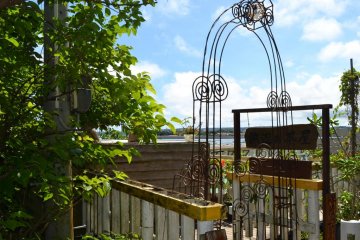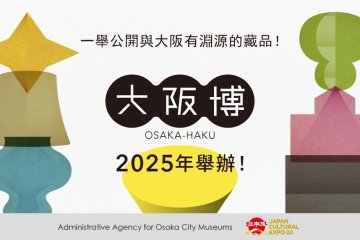Naha is one of Japan’s oldest trading ports and cities, predating and rivalling even that of Tokyo and Yokohama in its heyday.
Despite this, much of its history is not visible on the streets of Naha today, making a visit to the Naha City Museum of History a valuable discovery of how everything has changed, and giving us lessons for the future.
A melting pot of people
In the 1270's Marco Polo sailing between Naha and Fuzhou, spoke of Japan as the land of gold. A little over two centuries later Christopher Columbus sets sail for this fabled land, only to land in the Americas. It was no wonder that when Portuguese landed in Tanegashima Island between Naha and Kagoshima, they did everything to stop William Adams, a English ship pilot from setting a foothold with the Japanese authorities like the Shogun. While the Portuguese did not step onshore in Naha, traders from Naha met the Portuguese in Malacca.
In 1393 the Thirty-six Families of Fukien came to Naha to facilitate commerce between these two ports. These families formed the first Chinatown, bringing pork and noodles to the Okinawan diet. These days, there is little to distinguish the Chinatown from the rest of Naha, though their contribution was memorialised in the Fukushuen Garden.
In 1816 HMS Alceste and Lyre surveyed the islands of Okinawa, and a dying sailor became the first Englishmen to be buried here. Such was the caring response they received, the grave was marked "Here lies buried, aged twenty-one years, William Hares, Seaman, of His Britannia Majesty's ship Alceste. This monument was erected by the King and the inhabitants of this most hospitable Island". In 2024, there were 19,857 British nationals in Japan.
In 1853 Commodore Perry landed at Naha, and despite being an accidental nominee for the job (he wanted to be posted to the Mediterranean, such was the irony when comparing to Marco Polo), later signed a compact with the Ryukyu Islands. It was only after this in 1854, did he visit Yokohama, signalling the beginning of Japan’s transformation as a modern industrial nation. In 2024, there were 64,842 American nationals in Japan.
A melting pot of trade and commerce
Like many pre-historic civilisations, Naha’s economy was originally reliant on agriculture, but its poor soils made the island vulnerable to famine.
Around 1100, Polynesian seafarers brought back the sweet potato, a native of Ecuador, which was called Kumara to the Pacific, and later traded with various southeast Asian kingdoms before making its way to Fuzhou. This 5000-kilometer journey from South America by outriggers and celestial navigation is today celebrated at the Oceanic Culture Museum to the north of Naha.
While it was possible that Okinawan merchants and sailors would have tasted the sweet potato on their trade missions to Siam and Luzon, it was not until 1606 when it was grown in Government plantations, having made the journey from Fuzhou and transforming the nutritional wealth of this small city. Around the same time, the sugar cane was also introduced, creating a cash crop which was exported to Kagoshima.
While the Okinawan merchants were not as well known in the western world as the sailors from the Venetian city states, they were both trading at the same time in the Twelfth and Thirteenth centuries. Much of this traded centred around the ports of Fuzhou and Quanzhou, the latter previously known as Zayton زيتون, a hub of trade in goods and ideas between Chinese, Venetian, Persian, and Okinawan merchants on the maritime Silk Road.
Okinawan merchants would also trade spices, animals, and porcelain with Portuguese and Arab merchants in Malacca. The Arabs once described the Okinawans as fair but daring men, dressed in a cloak, and carry long swords like Turkish scimitars, a curved knife that is sometimes associated with pirates.
Other influences from Java, Malaya and the Indian subcontinent also came to Okinawa via the Port of Naha, including a textile dying technique known in Malay as ikat. In Okinawa it was called kasuri, which comes from the Japanese word for rubbing. Okinawan skills brought this to the highest degree of perfection. The Okinawan adaptation for turbans are called hachimaki, which was used to denote rank. The king at Shuri Castle would wear one studded with gems, one of which you can see at this museum, with a hairpin made of gold, while lower classes would have hairpins made of copper or wood.
There was also a time when the global recession hit the city hard, when overproduction has sent the supply up while demand dropped. Merchants and factory owners were in strife. We weren’t talking about fast fashion factory of the modern era, but reform of the feudal system had forced displaced samurai and labourers together. The new government was sweating not knowing what to do. Those events led to a diversification of industry to tourism, taking mainland Japanese to Okinawa to study an exotic and ancient culture. There was a time when Okinawan design was destined for the scrap heap, but Yanagi Soetsu from the Folk Crafts Museum came to study Bingata and Bashofu in 1939, helping to revive the value of Okinawan design and textiles.
Ships, Trains and Planes
The trading ships in the medieval times made Okinawa rich, much like the Venetian states, but the humble people at Naha kept it under wraps, there was not much in ostentation, particularly as they know that their island port was in the shadow of bigger powers nearby. In their journey to Siam, Malaya and the East Indies, a fleet of ships would depart Naha after the typhoon season and island hop their way using favourable winds.
As Japan opened up during the Meiji Restoration in the 19th Century, modern technology left Naha behind. Instead railways and steamships took people and goods from Tokyo via Kagoshima. Who would have thought that Naha was on the destination board at Tokyo Station, but replicas from that time are on display at the museum.
These days, planes connect Naha with the rest of Japan, and as far as Singapore and Thailand, continuing Naha’s historical connections with South East Asia.
Who is this museum suited for?
- As part of your orientation to Naha, this compact museum is a quick way (30 to 60 mins, closed Thursday) to induct yourself to the background of this multi-layered city.
- Discover what Naha was like, as much of the city was razed during the war, this is a unique chance to see pre War Naha, and even the Naha in the last century generally.
- Great to take the Okinawa diaspora. Emigration had a bigger impact on Okinawa than any other prefecture in Japan, one which is celebrated in the World Uchinanchu Festival
Who is it not for?
- Those wanting special effects, Imax or Team Lab like multi-sensory or interactive experience. This is strictly a display behind glass cases kind of museum with more mental and physical interaction, much like going to your old school library from the 1980s.
- They needing a guided tour, so this is a place for contemplation and discovery at your own pace.




























